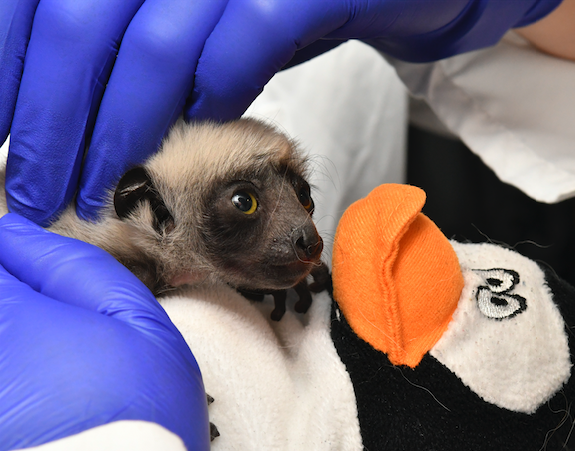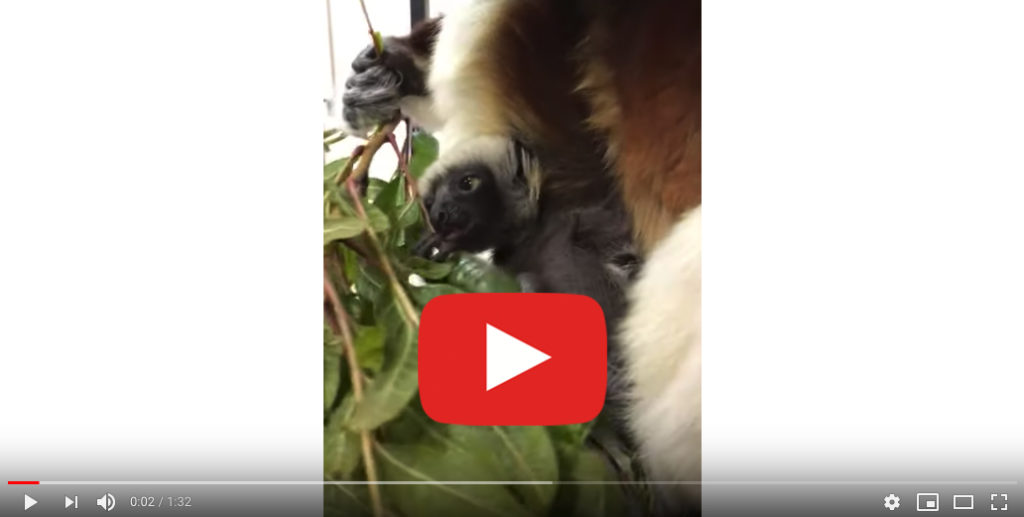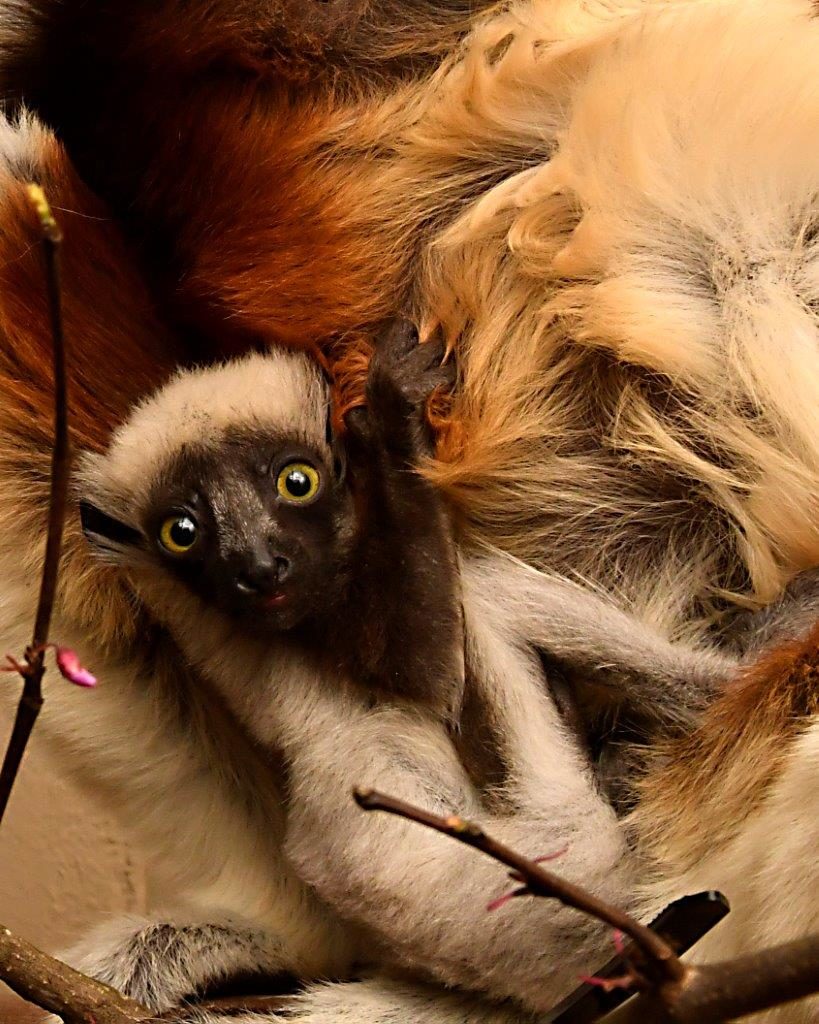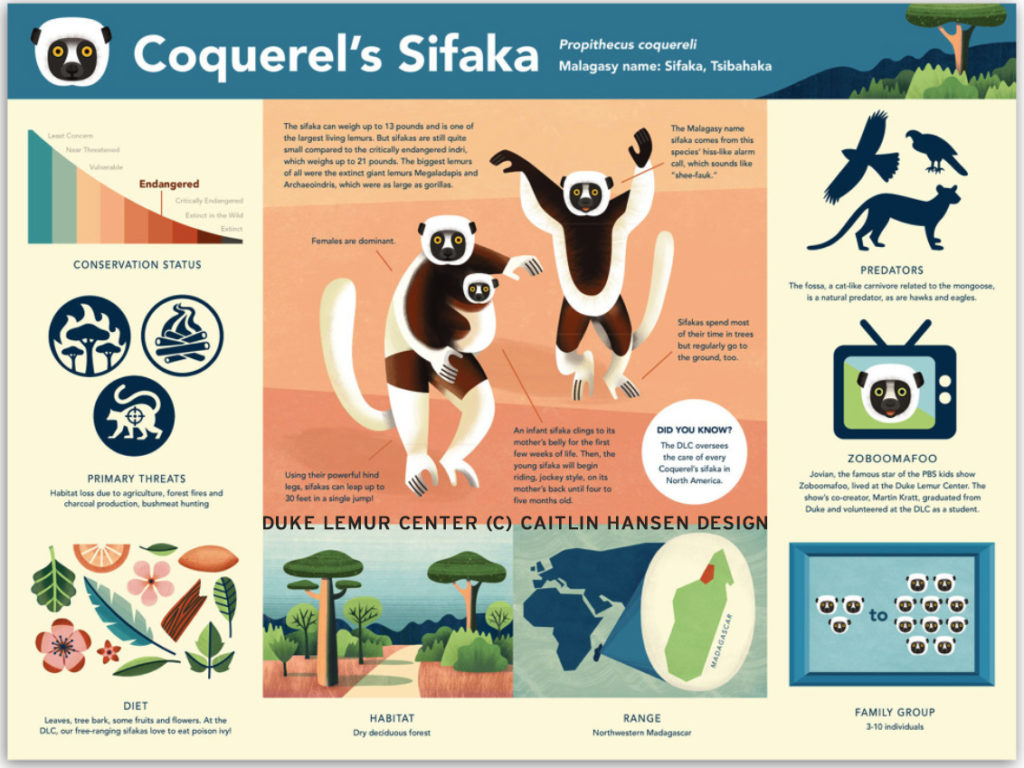Duke welcomes the newest granddaughter of Jovian, the famous Zoboomafoo

Marie clings to her mother’s abdomen. Coquerel’s sifaka infants cling to their mothers’ bellies for their first few weeks of life. Photo by David Haring.
Here at the Duke Lemur Center, birth season has begun! Please join us in celebrating the arrival of Marie, a critically endangered Coquerel’s sifaka born February 23, 2019 to first-time parents Gertrude and Remus!
In the Northern Hemisphere, Coquerel’s sifakas are typically born between December and March; Marie, who was born in late February, arrived just at the end of the normal birth season. Not only is she the DLC’s first infant of 2019, she is the granddaughter of Jovian, star of the Kratt brothers’ beloved PBS children’s show “Zoboomafoo.”
Marie is special, too, because she is the first infant born during the directorship of Greg Dye, new Executive Director of the Duke Lemur Center. “Even more importantly,” says Dye, “Marie’s birth strengthens the genetic safety net we’re building at the Duke Lemur Center to protect this critically endangered species from extinction.”
In Madagascar, Coquerel’s sifakas are threatened by habitat loss and hunting. As a group, lemurs are the most endangered mammals on Earth, with 95% of species at high risk of extinction. Coquerel’s sifakas were uplisted from endangered to critically endangered in 2018 by the International Union for Conservation of Nature (IUCN).
Because five-year-old Gertrude had been paired so recently with a brand-new male (the strapping Remus, age seven), Dr. Cathy Williams, the DLC’s Director of Animal Care and Welfare, hadn’t intended for them to breed quite yet. Gertrude received contraception during breeding season last summer, but in lemurs as well as in humans, no contraception method is 100% effective. “Gertrude and Remus got along very well indeed!” says Williams. “Marie was the unexpected but very welcome result.”
“It was such a surprise,” says Becca Newton, who was the family’s primary caretaker for Marie’s first weeks of life. Gertrude had been brought to the DLC’s veterinarians for a routine physical exam, which led quickly to the discovery of her “secret.” One of the veterinary technicians “scampered in to whisper the news,” Newton recalls, “and I was so excited! It’s the first time I’ve had a baby sifaka in my section.” On the one-month anniversary of the birth, Newton christened the infant “Marie.”
First-time parent Gertrude has been an excellent mother: Right away she was very attentive to Marie, cradling and grooming her tiny infant throughout the day. Marie weighed 108 grams at birth, slightly heavier than a deck of playing cards. Although she failed to gain weight during her first few days of life, by March 2 she began to improve, nursing well, maintaining weight, looking bright and alert, and clinging tightly to Gertrude’s abdomen.
Thanks to the care she received from her parents and the DLC’s veterinary and animal care teams, seven-week-old Marie is thriving. “Gertrude, Marie, and Remus have all settled in well,” says Williams.
“Any first-time mom or dad knows how stressful figuring out how to be a good parent can be,” says Dye. “To see these two first-time parents be so successful is a huge tribute to them and to the DLC’s amazing staff.”

Marie nestles into a stuffed penguin during a routine wellness exam by DLC veterinarians. The tiny sifaka is the granddaughter of Jovian, star of the Kratt brothers’ beloved PBS children’s show “Zoboomafoo.” Within the Lemur Center, Jovian was known as an exceptionally capable and caring father, having sired 12 infants with partners Alexianus and Pia. Gertrude, Marie’s mother, is the youngest daughter of Jovian and Pia. Photo by David Haring.

First-time parents Gertrude (with Marie clinging to her belly) and Remus enjoy redbud blossoms delivered to their “baby suite.” First-time dad Remus held Marie for the first time during a well-supervised introduction on March 6, holding her for about 10 minutes before Gertrude seamlessly took the infant back. Both parents wrestled and groomed each other and Marie throughout their time together, and Remus did well listening to Gertrude’s cues to give her a little space (although once she did elbow him once in the face – such is the life of a male sifaka!). Photo by David Haring.

Click the “play” arrow above to watch four-week-old Marie taste sumac leaves for the first time! Infant sifakas begin to sample solid foods and leaves at three or four weeks, and might begin to take a few tentative steps away from their mothers at this time. Nursing continues, in a steady decline in importance in the infant’s diet, until she is weaned at approximately five or six months of age. Video courtesy of Becca Newton.

Each species at the DLC has a unique naming theme. Duke’s sifakas are named for nobles of the Roman Empire and the and Holy Roman Empire, and Marie – who shares her name with Marie of Luxembourg, daughter of the Holy Roman Emperor Henry VII – is no exception. Photo by David Haring.

Sifaka infographic created for the Duke Lemur Center tour path (c) Caitlin Hansen Design. Click the image for a larger view.

Contact:
Sara Clark, Director of Communications at Duke Lemur Center
sara.clark@duke.edu
(919) 401-7251
Published April 11, 2019.

Further resources:
More great info about the Coquerel’s sifaka (Propithicus coquereli) is available on the species homepage on the DLC website.
Want to learn even more about sifakas AND help support their care, not only here but also in Madagascar? Consider symbolically adopting Pompeia, a female Coquerel’s sifaka, through the DLC’s Adopt a Lemur program! Adoption packages start at just $50, and every contribution helps provide the complex care that all lemurs, including Marie and her family, receive every day at the Duke Lemur Center.

